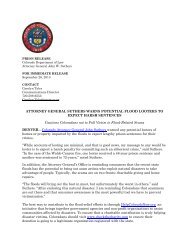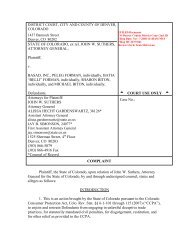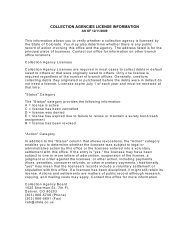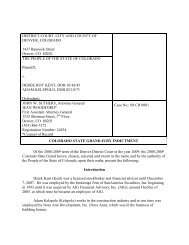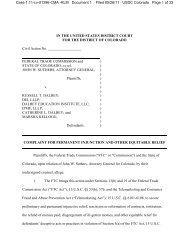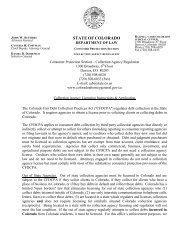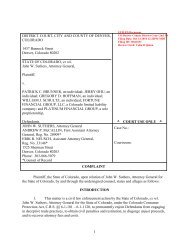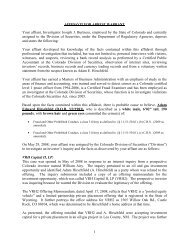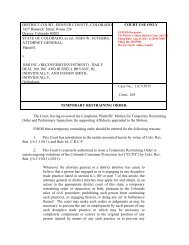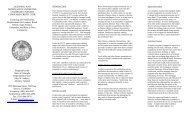brief in opposition to motion to dismiss - Colorado Attorney General
brief in opposition to motion to dismiss - Colorado Attorney General
brief in opposition to motion to dismiss - Colorado Attorney General
You also want an ePaper? Increase the reach of your titles
YUMPU automatically turns print PDFs into web optimized ePapers that Google loves.
and alter the boundaries of school districts, it is equally clear that it does not have the power <strong>to</strong>elim<strong>in</strong>ate school districts entirely from the system of public education. See, Board of Educ. ofSch. Dist. No. 1 v. Booth, 984 P.2d 639, 645 (1999). “If the <strong>General</strong> Assembly wants <strong>to</strong> changethis fundamental structure, it must either seek <strong>to</strong> amend the constitution or enact legislation thatsatisfies the mandates of the <strong>Colorado</strong> Constitution.” Owens, supra, 92 P.3d at 944.In Board of County Comm’rs of Douglas County v. Ba<strong>in</strong>bridge, Inc., 929 P.2d 691, 711(1996), the Court held that while provid<strong>in</strong>g a thorough and uniform system of public education isof state-wide importance which the Public School F<strong>in</strong>ance Act helps the state <strong>to</strong> achieve,“[c]ounties and school districts also have an important <strong>in</strong>terest <strong>in</strong> ensur<strong>in</strong>g that the needs of thestudent population <strong>in</strong> their districts are met.” 31In Booth, the Supreme Court recognized that thecontrol of <strong>in</strong>struction provision is a source of constitutional authority <strong>in</strong> school districts, which itdef<strong>in</strong>ed as the “power or authority <strong>to</strong> guide and manage both the action and practice of<strong>in</strong>struction as well as the quality and state of <strong>in</strong>struction.” Booth, supra,, 984 P.2d at 648. Aftera review of precedent, the Court further noted that “legislation must not usurp a local board’sdecision-mak<strong>in</strong>g authority.” Id., 984 P.2d at 649.Most recently, the Court reviewed and powerfully affirmed of the constitutional authorityof school districts under Article IX, §15, <strong>in</strong> Owens v. <strong>Colorado</strong> Congress of Parents, Teachersand Students, supra. In an extended discussion, 32 Owens articulates the “constitutional status oflocal control requirement,” and its function as an expression of the “framers’ preference . . . for31 The Court also noted that “[I]t is clear that the F<strong>in</strong>ance Act does not provide adequaterevenues for school construction.” Board of County Comm’rs of Douglas County v. Ba<strong>in</strong>bridge,Inc., 929 P.2d 691, 711 (1996). The Court had no difficulty <strong>in</strong> f<strong>in</strong>d<strong>in</strong>g manageable standards <strong>to</strong>arrive at this conclusion.32See Owens v. <strong>Colorado</strong> Congress of Parents, Teachers and Students, 92 P.3d 933, 937-45(2004).37



